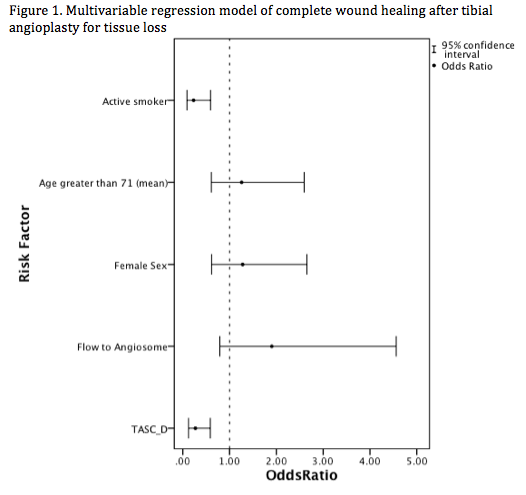|
|
 |
Back to Annual Symposium Program
Flow Restoration to Arteries Feeding Angiosomes of Foot Wounds Does Not Predict Better Wound Healing After Infrapopliteal Angioplasty
John C. McCallum, MD, Eduardo S. Cabral, Thomas Curran, MD, Jeremy D. Darling, BA, Dominique B. Buck, MD, Elliot L. Chaikof, MD, PhD, Mark C. Wyers, MD, Allen D. Hamdan, MD, Raul J. Guzman, MD, Marc L. Schermerhorn, MD.
Beth Israel Deaconess Medical Center, Boston, MA, USA.
OBJECTIVES:
It has been suggested that in patients with tissue loss, percutaneous transluminal angioplasty (PTA) which targets arteries mapped to wounds in idealized regions of the foot called “angiosomes” optimizes wound healing. We report our institutional rate of wound healing after PTA in patients in whom flow was restored to the angiosome of the wound, and those in whom it was not.
METHODS:
459 consecutive patients who underwent tibial angioplasty from 2004-2011 were identified retrospectively. Patients with an indication for intervention other than tissue loss were excluded. Flow was classified as having been restored to the angiosome corresponding to the wound if the intervention was performed on a vessel corresponding to the angiosome. Outcomes were analyzed via bivariate and multivariable logistic regression.
RESULTS:
363 patients underwent analysis of flow restoration. Flow was restored to the vessels feeding the angiosome in 234 (75%, n=312), and not in 78 (25%). There were no differences in comorbidities or infrapopliteal TransAtlantic Intersociety Consensus (TASC I) class among patients in whom flow was or was not restored to the angiosome. At 12 months, 86 patients (47%, n=181) had completely healed their wounds, and 95 (52%) had not. Bivariate analysis revealed anterior tibial artery intervention, active smoking and TASC-D class as predictive of failure to completely heal wounds (P=0.03, <0.01 and <0.01, respectively). Neither multi-vessel intervention nor restoration of flow in vessels mapped to the angiosome predicted healing (P=0.19 and 0.20, respectively). On multivariable analysis, multi-vessel intervention and flow restoration to the angiosome similarly did not predict healing (Odds ratio (OR) 1.17, 95%Confidence Interval (CI) 0.59-2.33 and OR 1.89, 95%CI 0.86-4.13 respectively). Active smoking was predictive of failure to completely heal wound (OR 0.23, 95% CI 0.09 -0.59) as was TASC D classification (OR 0.27, 95% CI 0.12-0.59) (Figure 1).

CONCLUSIONS:
Our approach is to treat the vessel or vessels seen on angiogram to provide best flow to the area of the wound, and we found that restoring flow to the predefined vessels mapped to the angiosome of the wound was no better.
Back to Annual Symposium Program

|


